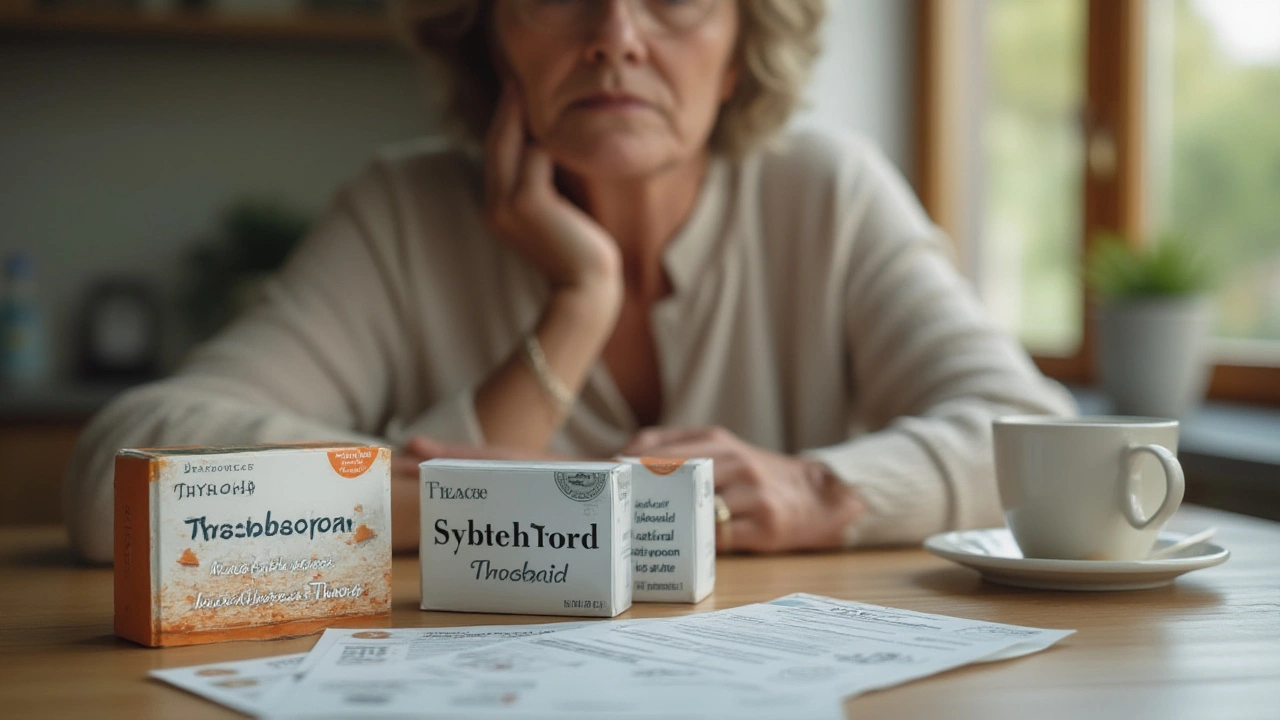If you ever find yourself counting pills after a lab report suggests your thyroid is lagging behind, you're not alone. The debate between desiccated thyroid and Synthroid (levothyroxine) is something doctors and patients love to pick apart. This rivalry has been brewing for decades, and yet, there’s still no clear winner. Why? Because people’s bodies just don’t read the manual. Some bounce back on Synthroid, others never feel right until they switch to desiccated thyroid. It's not just about popping what's on the pharmacy shelf—it’s about what actually gets your energy, mood, and weight back on track.
How These Thyroid Medications Work
Synthroid, the world’s go-to thyroid pill, is pure lab-made levothyroxine—a synthetic version of T4, that main thyroid hormone your body usually churns out from your neck. Once it’s swallowed, your system is supposed to convert T4 into T3 (the active hormone), and all should be well. Sounds neat, but bodies don’t always play along. Some people struggle with that conversion step. That’s where desiccated thyroid comes in. It’s made from dried pig thyroid glands, and it naturally contains both T4 and T3. Yes, you read that right—actual animal-derived hormone, and yes, it’s been used long before drug companies got clever with Synthroid.
The difference goes deeper. While Synthroid offers a stable dose of T4, desiccated thyroid shoves both hormones in together, which can make things unpredictable. You get a mix, typically in a 4:1 ratio for T4 and T3, but that ratio doesn’t look exactly like human thyroid output. Add to that, every batch of desiccated thyroid can have slight natural variations, which can mean your experience on it might swing a bit—some doctors like this approach for “natural balance,” others see it as too wild to control.
One of the key studies that stirred up the debate came out in 2013. Researchers at the Walter Reed Army Medical Center gave patients both medications in a crossover design. They found a third of people felt better on desiccated thyroid, but another two-thirds didn’t notice any difference at all. But—and here’s the kicker—blood levels looked about the same on both drugs. It really came down to how people felt, not their TSH numbers. This points to why the conversation keeps circling back: numbers can look perfect on paper even if you still feel awful. Fun fact: One out of six Australians with hypothyroidism reports recurring symptoms even on ‘ideal’ lab results. That’s a lot of people whose lives could be better with the right tweak.

The Dosing Dilemma: Predictable vs. Customizable
Let’s talk dosages, because this might be where things get personal. Synthroid comes in tiny, colour-coded tablets from 25 to 300 micrograms. Doctors love it because they can fine-tune your dose almost to the decimal point based on your blood tests. If your TSH is off, it’s easy to make a controlled adjustment. The trouble some people hit? Their symptoms might still linger, even on the “right” dosage. Sometimes this means the body isn’t converting T4 to T3 well, often because of age, stress, or genetics. You can’t just ask your body to try harder.
Desiccated thyroid is usually measured in grains, with one grain equaling 60-65 mg. Because it contains both hormones, changing the dose can be trickier. Make too big a jump and you might get jittery, anxious, or even trigger heart palpitations. Too little, and you’re stuck with low energy or brain fog. There’s no way to adjust the T3 and T4 levels separately—they come as a package deal. Some people thrive on this mix, especially if they have issues activating T4, while others find their mood and energy become too up-and-down. It’s a trial-and-error balancing act where symptom tracking matters as much as lab tests.
Patients swapping meds often go through a period of wild guessing as their doctor tries to find a conversion formula. Standard advice is that 100 mcg of Synthroid equals about one grain, but this isn’t universal—people metabolize hormones differently. Plus, generic versions of each medication may have slightly different absorption, leading to highs and lows in how you feel. If you switch brands or forms, check with your doctor about re-testing within a few weeks. And here's a tip: always take these meds at the same time daily, away from food, coffee, or supplements, to avoid absorption drama.
Want to see the full picture of what else doctors and patients are using in 2025? Check out this handy resource on Synthroid alternatives to get the latest lowdown on new and old options.

The Side Effect and Safety Showdown
Here’s the real stuff most people worry about: side effects. Synthroid is seen as safe and steady by most endocrinologists. The synthetic T4 means you won’t get any surprises, as long as you’re dosed correctly. But if you go too high, watch for symptoms like racing heart, sweating, insomnia, or anxiety. Too low, and it’s slow-motion mornings and a brain that feels stuck in syrup. Because it’s so well-studied, Synthroid has less unpredictability—though that doesn’t mean every patient feels great on their labs alone.
Desiccated thyroid brings with it all the quirks of a naturally sourced product: minor batch differences, plus the T3 punch that can feel like a double espresso for some people. Too much T3 and your heart can flutter, you get shaky, you might even lose weight unexpectedly or have trouble sleeping. This is precisely why people with heart disease or older patients have to be especially careful. You want energy, not an ambulance ride. Long-term, overdoing any thyroid hormone can thin bones or increase heart risks, so it’s not a set-and-forget affair. Still, for patients who live in a fog on T4 alone, these risks have to be balanced against actually functioning.
Some users swear that desiccated thyroid helps with hair growth, energy, and mood in ways Synthroid never did. Others find it sends them into a tailspin. The reality? Side effects often point more to dosing than to the drug itself. Get the dose right, and many people feel perfectly fine on either choice. The half-life of Synthroid is longer, so it stays in your body for weeks, smoothing out day-to-day fluctuations. Desiccated thyroid’s T3 portion acts much faster and shorter, which can bring more daily ups and downs but also helps some people who need a quick energy boost.
Here’s a handy tip: if you ever switch brands or formulations, insist on retesting. Even minor changes—say, from generic levothyroxine to brand name, or pig thyroid sourced from a new company—can subtly shift how the hormone hits you. The world of thyroid meds isn’t one-size-fits-all, and you know your own body best.
A final point: while you might hear internet horror stories about desiccated thyroid being banned or hard to get, it’s still available in Australia and most of the world, usually by prescription. Synthroid is easier to find and almost always covered by insurance, but it may not be the magic solution for everyone.
If there’s anything clear after all these years, it’s this—personal experience matters just as much as lab results. Don’t be afraid to question your options, ask for regular checks, and talk honestly with your doctor. Being your own thyroid detective will get you closer to feeling genuinely yourself again.







RaeLyn Boothe
July 28, 2025 AT 03:11